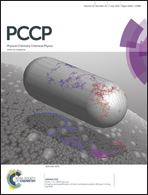Fluorescence response of a dipolar organic solute in a dicationic ionic liquid (IL): is the behavior of dicationic IL different from that of usual monocationic IL?†
Abstract
The solvation and rotational relaxation dynamics of coumarin 153 have been investigated in a dicationic ionic liquid (IL), 1,6-bis-(3-methylimidazolium-1-yl)hexane bis-(trifluoromethylsulfonyl)amide ([C6(MIm)2][NTf2]2), for the first time to provide a comprehensive and a quantitative understanding of the nature of the ionic fluid and its influence on the average solvation and rotational relaxation time. On several occasions, the photophysical data obtained in the present dicationic IL have also been compared with the monocationic imidazolium-based ionic liquid so as to find out the difference between their behaviors. The dicationic ionic liquid has been synthesized via a two step process and subsequently characterized by conventional spectroscopic methods. Steady state absorption and fluorescence measurements reveal that the polarity of the ionic liquid is close to that of dichloromethane. Steady state excitation wavelength dependent fluorescence measurement indicates the micro-heterogeneous nature of the ionic liquid. However, the steady state excitation wavelength dependent fluorescence response is found to be similar for both the dicationic and a structurally similar monocationic ionic liquid. In the time-resolved fluorescence studies, contrary to the monocationic imidazolium-based ionic liquid, no missing ultra-fast component of solvation has been observed in the present dicationic IL. Excitation wavelength dependence of the average solvation and rotation times also indicates the micro-heterogeneous nature of these media. When viscosity dependence (η) of the measured average solvation 〈τs〉 and rotation 〈τr〉 times are verified by the relation: 〈τx〉 ∝ (η/T)p (where ‘x’ is solvation or rotation, p is the exponent and T is the temperature), the fractional dependence of both average solvation and rotational times with the medium viscosity have been observed. The recent findings (J. Chem. Phys., 2012, 136, 174503; Chem. Phys. Lett., 2011, 517, 180; ChemPhysChem, 2012, 13, 2761) and the outcome of the present study suggest that the observed viscosity–diffusion (η–D) decoupling for the present dicationic ionic liquid is due to the dynamic heterogeneity of the medium.


 Please wait while we load your content...
Please wait while we load your content...